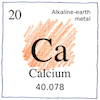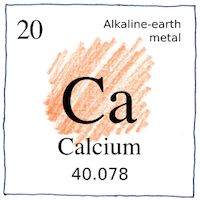London—Humphry Davy
elements

|
Calcium
Calcium carbonate is part of Earth’s carbon cycle and calcium is essential for all living organisms. Use of lime, limestone, and lime plaster goes way back, before over seven thousand years BCE. Roast the carbon dioxide out of limestone or seashells to get quicklime, calcium oxide. Lime was considered to be an undecomposable element until Humphry Davy decomposed it into oxygen and a metal.
Atomic number 20
Calcium carbonate for coral reefs. Calcite, aragonite, and vaterite. Limestone for the Rock of Gibraltar and Notre Dame in Paris. Quicklime binds concrete to hold up Hoover Dam and the Pantheon dome in Rome. Gypsum makes drywall. Alabaster makes lampshades. Terra alba coagulates tofu. Calcium in Tums and mineral supplements. Bigfoot prints cast with plaster of Paris.
Metallic stuff
Just in case you didn’t know, your body is full of metal, mainly calcium. It’s in your blood, teeth, and bones. To qualify this strange but true fact, one must observe that calcium does not exist in the body in chunks or sheets but as calcium hydroxylapatite in teeth and bones and as calcium ions in blood plasma where, to function, nerves and muscles need them.



The first three elements that Davy discovered using electrolysis (potassium, sodium, and calcium) are too reactive to occur as metals in nature but are essential nutrients for all animals.
See also in The book of science:
Readings in wikipedia:
Other readings: